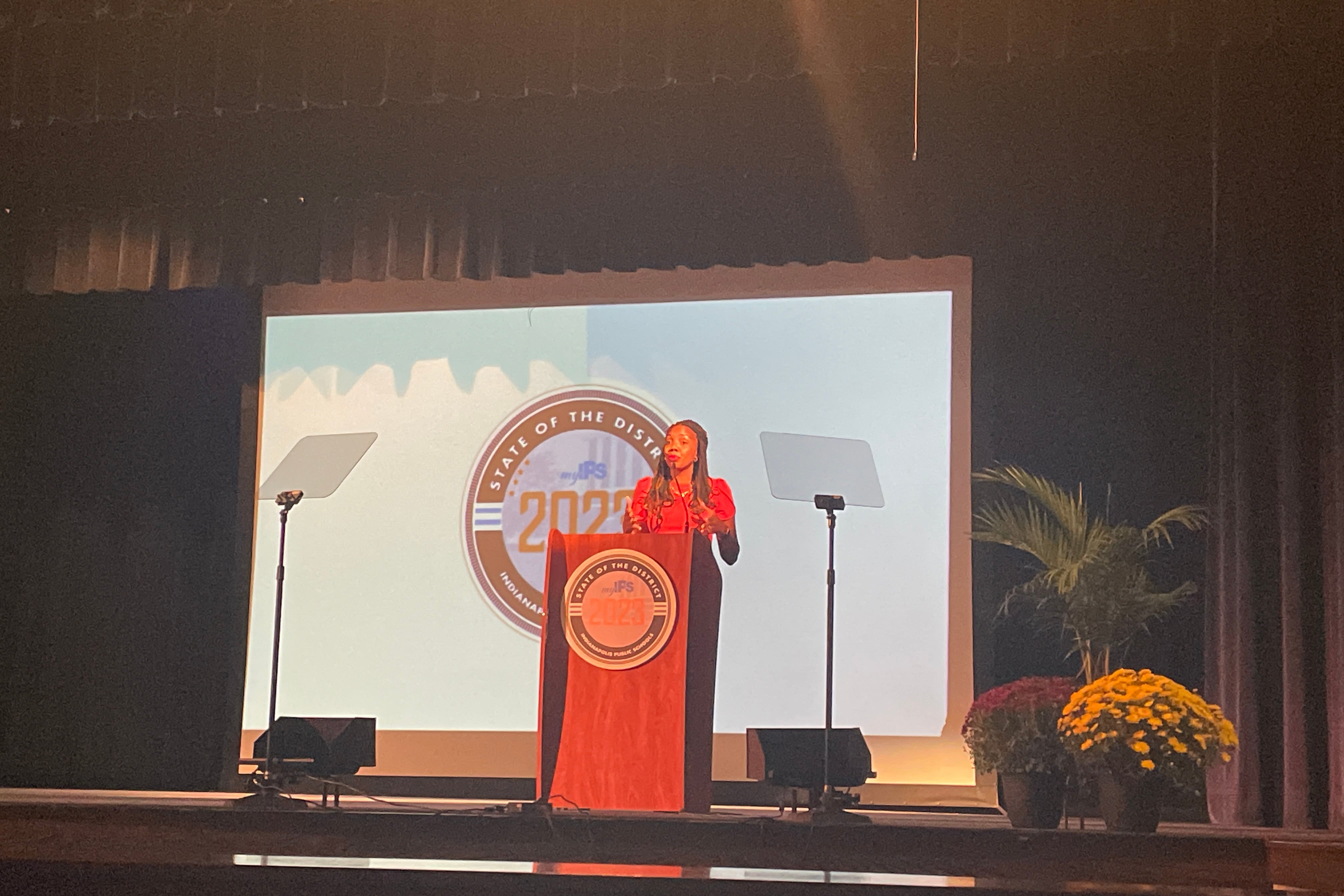Aleesia Johnson, superintendent of Indianapolis Public Schools, said she’s never been as excited for the State of the District speech as she was on Wednesday, when she invited all Indianapolis families to see the options IPS offers.
Her speech touted options available to students, largely through Rebuilding Stronger, the district’s overhaul plan, as the district aims to attract students and families.
The plan was unveiled at the State of the District last year, and this year’s speech is about keeping those promises, she said.
Johnson expressed her gratitude to the Indianapolis community for answering requests from the district including passing a capital referendum, sharing ideas, and giving the district grace and patience as changes were implemented, which included closing and merging some schools.
Johnson called the offerings now available to students “historic.”
“For as long as I can remember, our most exciting and comprehensive offerings were concentrated in neighborhoods that were whiter and wealthier,” she said. “Now, for the first time, every family in our city can access our best stuff. What was once a privilege is now a right.”
Here’s what to know from Johnson’s speech:
IPS is ‘making up ground’
Johnson highlighted the district’s recent academic gains. In 2023, a greater share of the district’s students scored proficient on both the reading and math sections of the state ILEARN test than before the pandemic in 2019. (Passing rates on IREAD declined from 62.8% last year to 60.6% this year.)
“While much of the country is still experiencing major academic setbacks, we at IPS are already making up ground. We now have a greater share of students at or above pre-pandemic performance in both reading and math, and we’re the only district in Marion County that can make that claim,” she said. “This is a nationally significant achievement.”
Additionally, Johnson said the graduation rate has grown to 80%, which cut in half the gap between IPS and the state graduation rate, which was 86.61% in 2022.
That is “a direct reflection of the work our team began in 2018 to reinvent our high schools and transition to college and career pathways,” she said.
District extends an invite to ‘every family in Indianapolis’
Every family with school-age children will receive an invitation in the mail, Johnson said. That invitation, expected in two weeks, asks families to “choose your IPS” that is “tailored to your child’s needs, interests, and hopes.”
In addition to the mailer, Johnson said IPS will have a “showcase of schools” in early November where all schools will be open for families to visit. Plus, school staff will reach out to current families to answer questions; there will also be open houses and information sessions.
This “whole new chapter” is the payoff for doing hard things as part of the district’s reorganization, she said. And it’s ending ways that “reinforced old patterns of haves and have-nots, of segregation, of intentional disinvestment.”
“Every family in Indianapolis is invited,” she said. “Every family.”
Offerings reflect that students’ ‘talent is everywhere’
Johnson said options available to students previously varied from neighborhood to neighborhood, meaning some students and families were left out.
“The way we did it before would have made perfect sense — if all the future violinists were born in one neighborhood, and all the computer coders in another,” she said. “But I’m pretty sure talent is everywhere so we need to make sure opportunity is as well.”
The new approach includes more pre-K options and more high-demand instructional models for elementary school such as Montessori, dual language immersion, and others. For older kids, all middle school students now have access to band and orchestra, world language, algebra I, computer science, and music, she said. This is a change from the past, when not all schools offered these programs.
At the high school level, options continue, Johnson said, listing choices from “Law and Public Safety to Media Arts and Design to Computer Science and Advanced Manufacturing.”
Plus, she said programs in health care, IT and cybersecurity set students up for internships, industry certifications, and dual credit programs.
Beyond academics, Johnson said athletic offerings are expanding, including girls flag football at all four district-managed high schools as well as more elementary and middle school sports camps and clinics next year.
Investments also include updated buildings – by the end of September, 30 schools will have updated HVAC systems and design work is underway for other buildings, she said.
Nearly $100 million of capital referendum projects will be facilitated by a minority-, women-, or veteran-owned business, she added.
Johnson looks to the future needs
While Wednesday’s speech largely centered on touting exciting parts of the future, Johnson said she knows she’ll likely have speeches where she’ll have to make tough asks.
She also acknowledged that she’d likely have to make more tough requests of the community. And she called for the community to come together more for students.
She noted that resources are needed for students who are non-native English-speaking learners, students with disabilities, and 3- and 4-year-old early learners.
“We can invest in solutions that make it possible for working parents to support their families while their children learn,” she said, adding that investing in students is also investing in a strong economy of the future.
“It’ll take all of us, fighting for what our students need. But there are solutions and, together, we have them,” Johnson said. “Indianapolis has shown me that time and time again.”
Chalkbeat reporter Aleksandra Appleton contributed to this article.
MJ Slaby oversees Chalkbeat Indiana’s coverage as bureau chief and covers higher education. Contact MJ at mslaby@chalkbeat.org.







